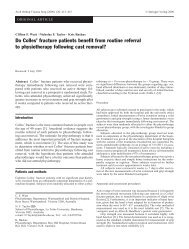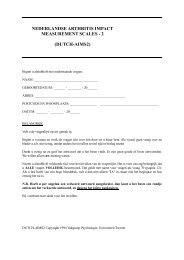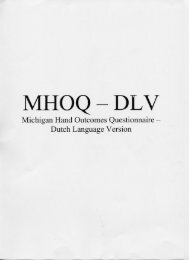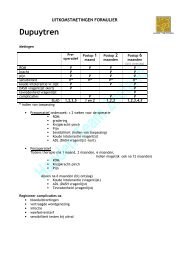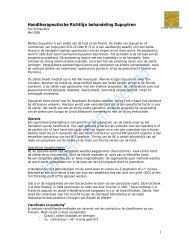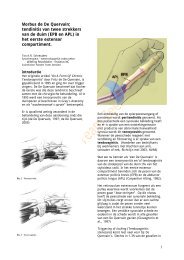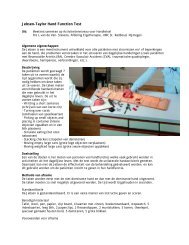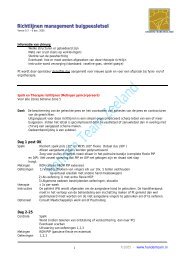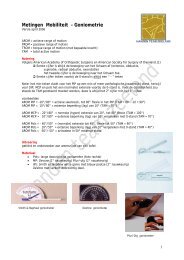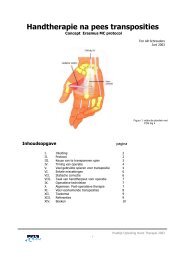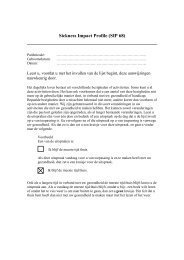Muscle strength measurements of the Hand - Handen Team Zeeland
Muscle strength measurements of the Hand - Handen Team Zeeland
Muscle strength measurements of the Hand - Handen Team Zeeland
Create successful ePaper yourself
Turn your PDF publications into a flip-book with our unique Google optimized e-Paper software.
Ton A.R. Schreuders, JW Brandsma, HJ Stam<br />
holding a key with paralysis <strong>of</strong> intrinsic<br />
muscles <strong>of</strong> <strong>the</strong> hand can become<br />
impossible (Figure 1).<br />
Figure 1. A patient with loss <strong>of</strong> all intrinsic<br />
muscles holding a key.<br />
<strong>Muscle</strong> <strong>strength</strong> testing<br />
For many centuries measuring<br />
muscle <strong>strength</strong> has been an area <strong>of</strong><br />
interest for those who have been studying<br />
and are responsible for diagnosing many<br />
diseases that are accompanied by loss <strong>of</strong><br />
<strong>strength</strong>. 5 Numerous neurological<br />
diseases are accompanied by atrophy <strong>of</strong><br />
<strong>the</strong> intrinsic muscles <strong>of</strong> <strong>the</strong> hand.<br />
Therefore, muscle function <strong>strength</strong> testing<br />
is frequently used for clinical decision<br />
making in rehabilitation medicine,<br />
neurology, hand surgery and physical<br />
<strong>the</strong>rapy. The purpose <strong>of</strong> this muscle<br />
<strong>strength</strong> testing is, besides diagnosis, to<br />
evaluate and compare treatments, to<br />
document progression or regression <strong>of</strong><br />
e.g. muscle <strong>strength</strong> during rehabilitation,<br />
to provide feedback during <strong>the</strong><br />
rehabilitation process, and to evaluate<br />
handicaps/restrictions <strong>of</strong> participation after<br />
injury. 6<br />
In an historical outline <strong>of</strong> manual<br />
muscle <strong>strength</strong> testing 7 (MMST), <strong>the</strong> first<br />
person to design a numerical system <strong>of</strong><br />
grading muscle action was Lowman in<br />
1911, followed closely by Lovett who<br />
introduced <strong>the</strong> testing grades based on<br />
gravity. 8 The British Medical Research<br />
Council (MRC) specified a similar 0 to 5<br />
scale where complete paralysis is graded<br />
as 0, grade 3 is when <strong>the</strong> limb segment<br />
can be moved actively against gravity, and<br />
grade 5 is normal <strong>strength</strong>. 9 The<br />
procedure for MMST is simple in that no<br />
equipment is needed. The hand <strong>of</strong> <strong>the</strong><br />
examiner is used to feel <strong>the</strong> muscle<br />
activity and to give resistance to determine<br />
which grade <strong>the</strong> muscle can be given<br />
(Figure 2).<br />
Figure 2. Testing <strong>the</strong> abduction <strong>strength</strong> <strong>of</strong> <strong>the</strong><br />
little finger (ulnar innervated hypo<strong>the</strong>nar<br />
muscles); <strong>the</strong> right hand <strong>of</strong> <strong>the</strong> examiner gives<br />
resistance to determine which grade <strong>the</strong><br />
muscle can be given.<br />
The most frequently used<br />
textbooks on MMST are still based on this<br />
early system <strong>of</strong> muscle grading, e.g.<br />
Kendall and Kendall 10 and Daniels L.<br />
Worthingham. 11 Some modification for<br />
MMST <strong>of</strong> <strong>the</strong> hand has been proposed by<br />
Brandsma et al. 12 In MMST <strong>of</strong> <strong>the</strong> hand,<br />
gravity is not taken into consideration,<br />
<strong>the</strong>refore grade 3 is considered as <strong>the</strong><br />
ability <strong>of</strong> <strong>the</strong> muscle (group) to perform a<br />
full range <strong>of</strong> motion (ROM). When <strong>the</strong><br />
interossei and lumbricals are tested as a<br />
group in <strong>the</strong> intrinsic plus position (MCP<br />
flexion and IP extension), grade 2 is given<br />
when <strong>the</strong> proximal interphalangeal (PIP)<br />
joint extension is less than 30° short <strong>of</strong> full<br />
extension.<br />
Brooke modified <strong>the</strong> 0-5 scale into<br />
an 11-point scale, adding “+” and “-“. 13 A<br />
9-point scale has been investigated by<br />
Brandsma et al. for reliability in patients<br />
with neuritis due to leprosy. 14 Strength was<br />
graded on a modified MRC scale with 9<br />
grades: 5, 4+, 4, 3+, 3, 2+, 2, 1 and 0.<br />
Overall agreement appeared to be good or<br />
very good (Kappa; 0.61-1.00). However,<br />
when data for hands with normal <strong>strength</strong><br />
(grade 5) or complete paralysis (grade 0)<br />
were excluded from <strong>the</strong> analysis, <strong>the</strong><br />
2



